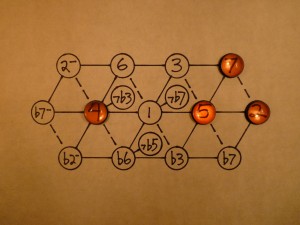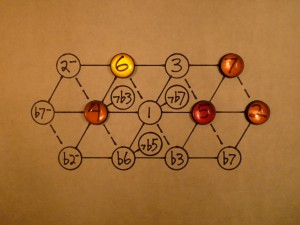The Power of the Seventh Chord
The V chord, the major chord based on the 5, is a powerful compositional tool. It points, very clearly and with a lot of tension, directly at the tonic. If you want to lead the ear to the I, the V chord is the top-of-the-line triad.
Why this is so is still a bit mysterious to me. It’s been discussed a lot. It seems to have both melodic and harmonic elements.
Melodies “like” to move short distances in pitch, and the move from the V to the I is elegant melodically. The 7, or major seventh, resolves up a half step to the 1. The major seventh is called a leading tone because of this very property. The 2 drops a whole step, also to the 1, and the 5 stays put.
In harmonic space, voices, especially roots, “like” to move short distances too. The shortest move of all is a fifth, and when the V goes to the I, the root moves down by a fifth. It seems natural that if the ear is anticipating the next chord, it will place its bet on the change that expends the least energy. All three notes could be seen as moving that same short distance, the easiest possible move.
I like to think of it in terms of tonal gravity. The tonic, the 1, is like a sun at the center of a solar system, and it exerts a gravitational pull. Moving away from it creates tension, collapsing into it creates resolution. Just as with gravity, the closer in you are, the stronger the force. The V is right next to the I, harmonically, so the tension is very strong.
The V chord isn’t the last word, however. It’s possible to crank it up, by adding another tense note.
The 4 and the 5 are the closest notes to the 1, in harmonic space. These two notes have the strongest tonal gravity of all. Their effect is different — 5 is the strongest overtonal note, and 4 is the strongest reciprocal note. Both point straight at the tonic.
Melodically, the 4 is two half steps below the 5. This makes it a flatted or minor seventh, added to the V chord. So the final chord is called a V7.
Of all the notes we could add to the V chord, the 4 creates the most tension, and it’s pointed directly at the tonic. I say this is the source of the power of the dominant 7th chord.
In Be Love, I add even more tension before I’m through. The melody dances around, and right before the final resolution, it lands on the 6.
I’ve added yet another tense note to the mix. It’s not as strong as the 4, but it jacks up the gravity another notch. The root is on 5, so the 6 is two half steps up from it melodically. This makes it a ninth chord — start with the basic major triad, and add a seventh and a ninth.
Now I’m set up as strongly as possible for a return to the tonic, and sure enough when the drop happens it lands with authority. I’m in major land now, and the chorus will feel entirely different from the verse.
Here’s the whole effect:
Next: To the Far Northwest

